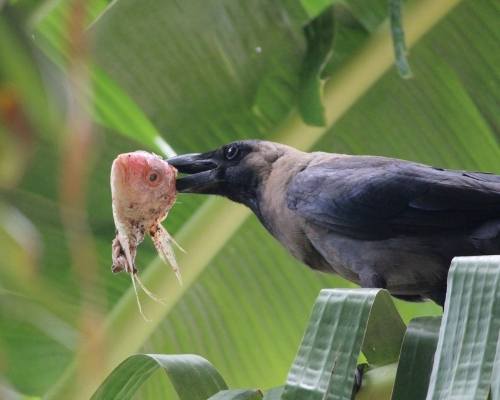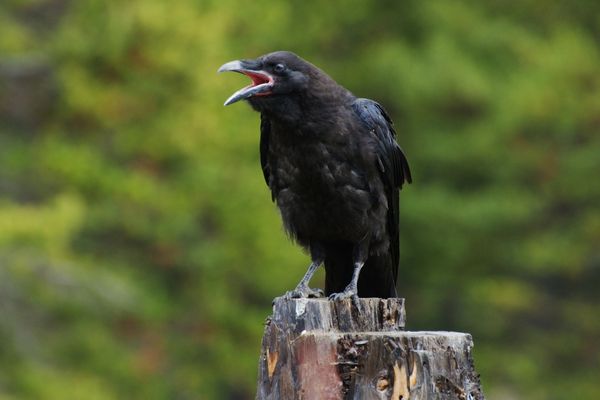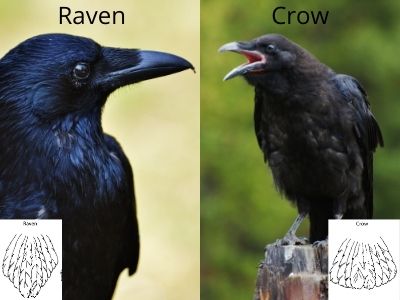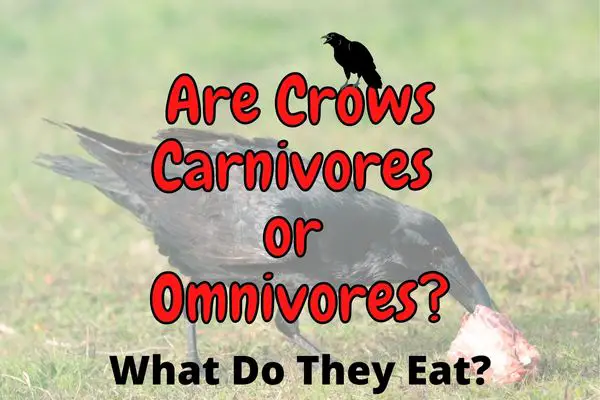Crows are opportunistic feeders that will take advantage of whatever food is available. This makes them very adaptable to different habitats and means that they can live in close proximity to humans.
Crows are common birds of the family Corvidae and are related to magpies, rooks, and jays. There are many different species of crow around the world, and they all have two primary characteristics – a dark black color and their well-known call sounding: “craaa, craaa”!
Crows are omnivorous birds that are found all over the world. In the wild, they eat a variety of food items including insects, small mammals, reptiles, frogs, eggs, and carrion. But they will also eat fruit, nuts, and seeds when animal nutrition is unavailable.
As an omnivore, the crow has a diet that consists of both plants and animals. However, the vast majority of their diet (up to 90%) is made up of invertebrates such as insects and earthworms. The rest of their diet includes fruits, seeds, nuts, and garbage for crows that live in cities.
So crows are omnivores and not carnivores?
Crows are omnivores because they eat both plants and animals, but they do prefer to eat animals as these are higher in the proteins and nutrients they need.
When you are an omnivore, you are also a carnivore and a herbivore at times, but crows are closer to being a carnivore than a herbivore.
Crows are highly opportunistic birds and can be classified as omnivores, meaning they have a diet that consists of both plant and animal matter. Their diet varies depending on the availability of food in their environment.

While crows are often associated with scavenging and consuming carrion (dead animals), they are not strictly carnivorous. They will readily feed on a wide range of food sources, including insects, small vertebrates like mice and lizards, eggs, fruits, grains, nuts, and even garbage or human food scraps.
In terms of their hunting behavior, crows are known to exhibit tool-using capabilities. For example, they may use sticks or other objects to extract insects or grubs from tree bark. They are also known to steal eggs from other bird nests or raid agricultural fields for crops.
In urban environments, crows often scavenge from garbage bins or forage in city parks for food. They are highly adaptable and can exploit various food resources depending on their availability. This adaptability has contributed to their success in a wide range of habitats around the world.
It’s important to note that while crows are opportunistic feeders, they still have preferences and nutritional needs. They require a balanced diet to maintain their health and reproductive success. Their ability to switch between different food sources allows them to survive in diverse environments and thrive in various conditions.
Where do crows live?
Woodlands, fields, and forests are the most common natural habitats for crows, but as you properly know, they are also widespread in cities and backyards!
However, their natural habitat is open country with scattered trees, scrub/bush areas, and other kinds of woodland.

They often nest inside hollow trees but will also find holes in fences and abandoned buildings to nest in if there is no suitable tree available.
What do crows eat?
Crows are opportunistic feeders that will eat anything they can get. In the wild they mainly eat insects, small mammals, reptiles, amphibians, nuts and berries.
Their diet changes between seasons as different food types become more abundant or as they grow bigger and can handle larger food items like small mammals.
However, in the mating season and during the summer, the diet of crows would suggest that they are mostly carnivores. However, in fall, they forage heavily on fruits, nuts and seeds as well.
Crows have a varied diet and can consume a wide range of food sources. Here are some of the most commonly eaten foods by crows:
- Carrion: Crows are known to scavenge and feed on carrion, which includes the carcasses of dead animals.
- Insects: Crows feed on a variety of insects, including beetles, grasshoppers, caterpillars, and grubs. They may use tools, such as sticks, to extract insects from crevices.
- Small vertebrates: Crows prey on small vertebrates like mice, rats, lizards, frogs, and small birds. They are opportunistic hunters and may raid other bird nests for eggs or chicks.
- Seeds and grains: Crows consume a variety of seeds and grains, including those from grasses, crops, and trees. They can be found foraging in agricultural fields or searching for fallen seeds.
- Fruits: Crows have a fondness for fruits and will eat a range of options, such as berries, apples, cherries, and figs. They may also help in seed dispersal by eating fruits and spreading the seeds elsewhere.
- Nuts: Crows are known to crack open nuts using their beaks and eat the kernels inside. This includes nuts like acorns, walnuts, and hazelnuts.
- Garbage and human food scraps: In urban environments, crows scavenge from garbage bins and may consume leftover human food. They are quick to adapt to such food sources when available.
It’s important to note that the specific diet of crows can vary depending on their geographical location, seasonal availability of food, and local ecological conditions. Crows are opportunistic feeders, and their diet may include other items based on what they find in their surroundings.
During spring and summer time they prefer to eat worms, insects, larvae (including those of ants), grasshoppers and beetles, caterpillars (particularly army worms), snails and slugs (the latter particularly when they are young) as well as eggs of other birds such as sparrows, jays, cardinals and pheasants.
But they will also eat water animals such as frogs, fish, and tadpoles!
They may take small songbirds or their eggs that they find on the ground but these are usually only taken when they have nothing better to do, e.g. if it has been raining heavily all day and there is little prey elsewhere because everything is hiding from the rain rather than actively hunting for food themselves.
This was seen quite recently during Hurricane Katrina when many animals were killed by the storm itself including many birds whose bodies were then picked over by predators looking for food so that some predator species increased greatly, but temporarily while others such as foxes remained largely unchanged.
This kind of event changes the competition against other species for food, but luckily for the crow, most other bird species are afraid of crows!
What Type of Consumer is a Crow?
Crows forage mostly as secondary consumers, although they may behave as both primary and tertiary consumers as well.

Omnivores are secondary consumers, herbivores are primary consumers and carnivores are tertiary consumers. Few species are quaternary consumers or apex predators.
Can Crows be Considered Decomposers?
Crows are primarily omnivores, but they do scavenge for dead animals and small reptiles. Therefore, some scientists also consider them scavengers.
However, crows do not eat dead or decaying matter as their primary diet and are therefore not considered decomposers or detritivores.
The bacteria and fungi in the gut of the crow play a very important role for their digestion and these microorganisms may be considered true decomposers.
Where are Crows in the Food Chain?
As omnivores, crows are secondary consumers because they eat both plants and animals. The animals that eat the animals they eat are tertiary consumers.

Crows occupy various positions in the food chain depending on their ecological context and specific interactions within their environment. Here’s a general overview of where crows typically fit within the food chain:
- Consumers: Crows are primarily consumers within the food chain. As omnivores, they feed on a wide range of food sources, including insects, small vertebrates, fruits, seeds, and carrion. They obtain energy and nutrients by consuming these organisms.
- Secondary consumers: Crows can also act as secondary consumers when they prey on smaller animals such as mice, rats, lizards, and small birds. In this role, they occupy a higher trophic level, feeding on primary consumers.
- Scavengers: Crows are opportunistic scavengers, feeding on carrion and dead animals. By consuming carrion, they help break down organic matter and contribute to nutrient cycling in ecosystems. They play a role in cleaning up decaying remains.
- Predators: While crows primarily feed on smaller animals, they may occasionally prey upon eggs and chicks of other bird species. They can be considered predators when they actively hunt and capture these vulnerable prey.
- Prey: Crows can become prey themselves for larger predators such as raptors (e.g., owls, hawks, and eagles), snakes, and larger mammals. These predators may target crows for food or territorial reasons.
- Ecological interactions: Crows also have interactions with other organisms within their habitat. They may compete with other bird species for nesting sites, food, and territory. Additionally, crows may engage in mutualistic relationships with other animals, such as benefiting from associations with other species that help them locate food sources (e.g., wolves or humans disturbing prey) or by mobbing potential threats to their nests or group members.
It’s important to note that the position of crows in the food chain can vary across different ecosystems and geographical locations. Their adaptability and ability to exploit a variety of food sources contribute to their ecological success in different habitats.
The crow is an important animal in the ecosystem because it is an omnivore. As a predator, the crow helps to keep the population of other animals in check, which helps to maintain balance in the ecosystem.
In addition, the crow is a scavenger and helps to clean up the environment by eating dead and decaying animals so they don’t pile up in your yard!
Are Crows Autotrophs or Heterotrophs?
Crows are heterotrophs because they eat other living organisms. Practically no animals are autotrophic because animals do not get their energy directly from the sun like plants do. That is, animals like the crow cannot make their own energy!
What Animals Prey on Crows?
Crow may be eaten by larger carnivores like foxes, cougars, wolves, snakes and birds of prey.
Few common backyard birds will eat a grown-up crow, but some will attack it and chase it away!

Crows are actually quite high up in the “pecking order” when it comes to backyard birds, and you can read much more about what birds the crow is able to scare away in my recent article about the crow’s role in the bird feeder hierchy!
Conclusion
In this blog post, I have looked into the diet and feeding habits of crows, a bird that many of us are very familiar with.
Crows are common birds of the family Corvidae, meaning they have a beak-like bill. There are many different species of crow around the world like the American crow or the raven (yes it is a type of crow!).

Crows are omnivores: they eat fruit, insects such as caterpillars and crickets, buds on trees, worms, and snails.
Crows are very curious birds and will eat just about anything. They are notorious for stealing food when the opportunity arises, including all sorts of other bird’s food!
Crows were once considered as pests because they would take eggs from nests, but now many people find crows quite endearing as opportunistic feeders, and not particularly aggressive.
I would certainly recommend trying to feed crows if you ever get the chance! They are quite amusing to watch and you will learn a lot about their feeding habits. They are super smart and fascinating creatures. Some say they have the IQ of a seven-year-old!
If you enjoyed this post, why not take a look at some of my other interesting blog posts!



